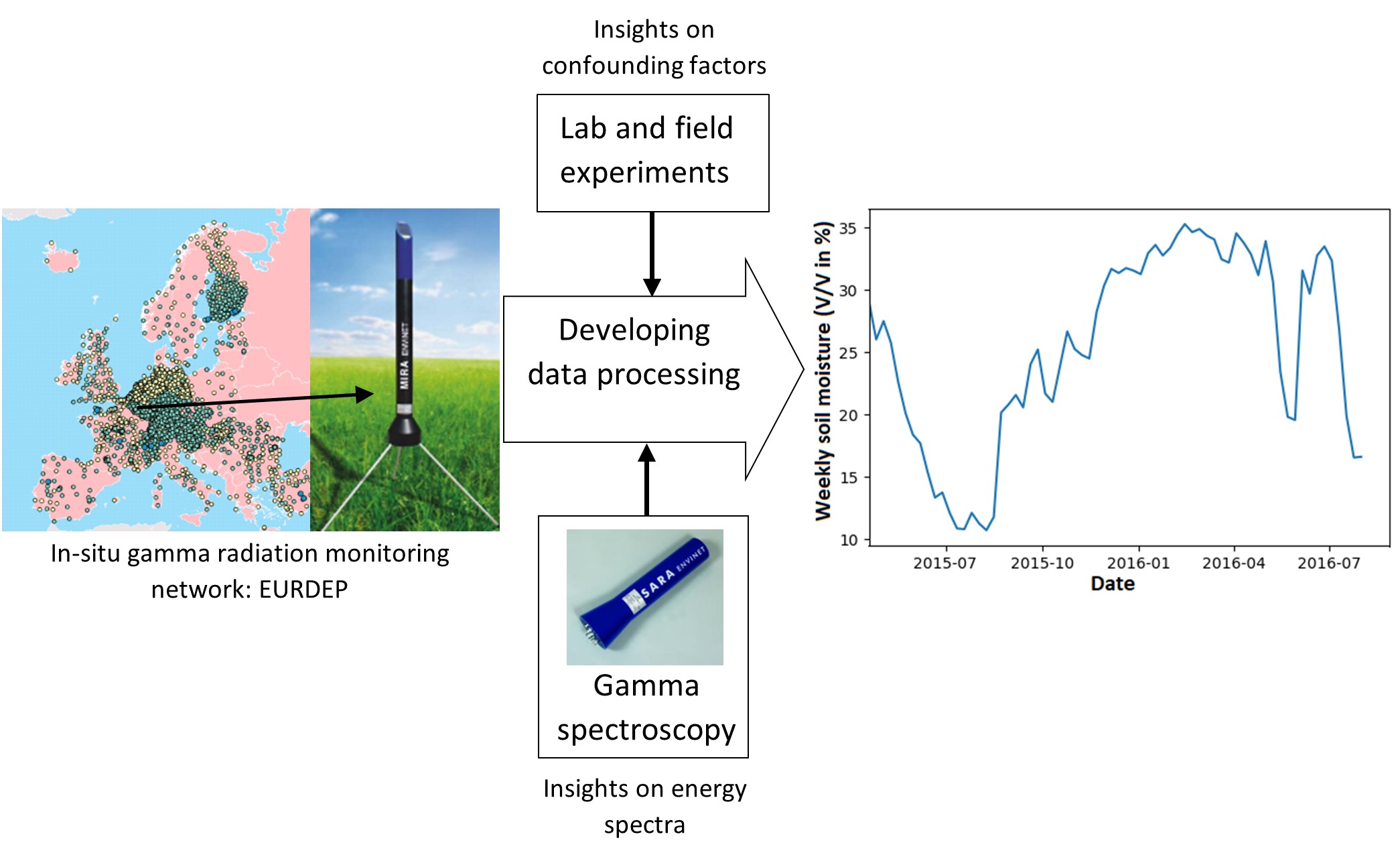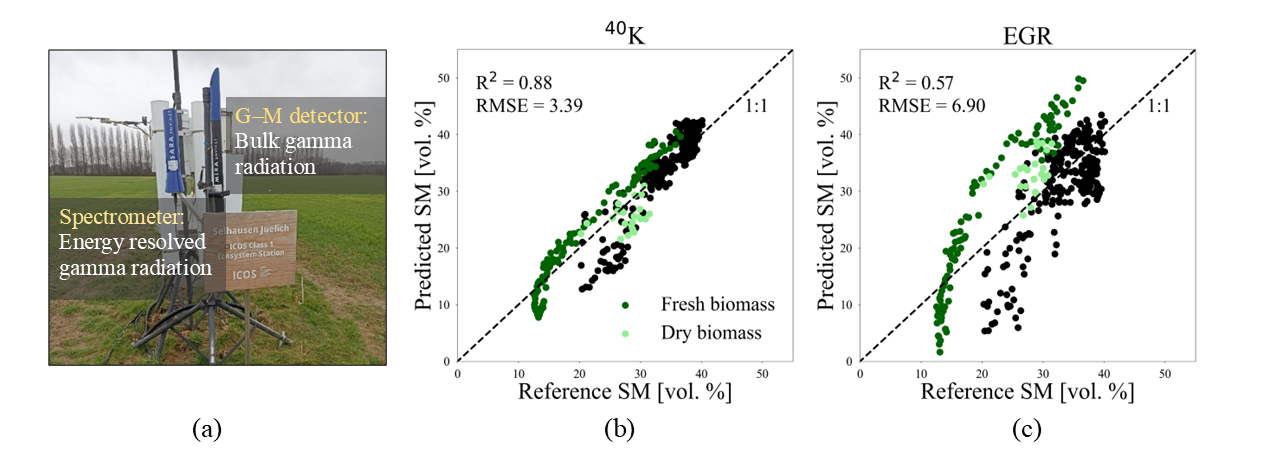A02
Estimation of root zone soil moisture from gamma radiation measurements
Prof. Dr. J.A. (Sander) Huisman
Forschungszentrum Jülich | +49-2461-618607 |
Summary
Root-zone soil moisture (SM) is an essential variable in land surface models, but there is still a lack of sensing information that adequately represents this zone. The first main hypothesis is that a root-zone SM product for Europe can be derived from existing gamma radiation data from the European radiological data exchange platform (EURDEP). For this, it is important to understand how infiltration, evaporation, transpiration, and secondary cosmic radiation affect measured gamma radiation. This will be achieved with both laboratory and field experiments and the analysis of available gamma radiation time series. The insights obtained will be used to develop data processing strategies and an observation operator that relates SM to gamma radiation. This operator will be coupled to a hydrological model to validate the performance for SM estimation and the improved estimation of soil hydraulic parameters.
Graphical Summary

Contribution to CRC
Project A02 will closely collaborate with A01 and A03 through joint experimental work and data analysis and a common modeling approach (SiSPAT-Isotope). The main focus of A02 is to work towards developing a new soil moisture data product at the European-scale to improve the accuracy of the TerrSysMP integrated modelling system (IMS). This requires the development of an observation operator for gamma radiation to enable data assimilation into TerrSysMP IMS.
Main Results in 2022-2025
Using existing longer time series of two gamma radiation monitoring stations from a pilot study conducted on the FZJ campus, we developed methods to isolate the terrestrial component of environmental gamma radiation (EGR) measurements. This began with filtering the EGR data to eliminate the influence of atmospheric radon washout by excluding periods of precipitation. Next, we separated the terrestrial gamma radiation (TGR) component by removing the contribution of secondary cosmic radiation. This required applying corrections for atmospheric pressure and variations in incoming cosmic-ray flux. To relate SM to TGR—serving as the observation operator—we derived a general relationship based on existing theoretical frameworks. Following correction, our observation operator was fitted to the EGR and SM reference data, which were aggregated to a weekly time scale to reduce measurement noise (Fig. 1a). The results showed that the terrestrial component of EGR effectively captured the seasonal variability in SM (Fig. 1b), although with a relatively high error of approximately 9 vol.% (Fig. 1c). These initial findings were published in Akter et al. (2024).

Fig. 1. a) Weekly absolute terrestrial gamma radiation (TGR) as a function of weekly reference soil moisture (SM) as well as b) seasonal dynamics and c) reference versus predicted SM for a test site at the FZJ campus. R2 indicates the coefficient of determination, and RMSE is the root mean square error.
Next, co-located environmental and spectral gamma radiation measurements at the Selhausen test site were used to assess the extent to which confounding factors affect the accuracy of SM estimates derived from EGR (Fig. 2). We found that daily SM could be predicted from ⁴⁰K measurements with a root mean square error (RMSE) of 3.4 vol.% (Fig. 2b). In contrast, EGR-based SM estimates showed lower accuracy (RMSE of 6.90 vol.%) (Fig. 2c). Wavelet coherence analysis indicated that EGR measurements were influenced by atmospheric radon-induced noise during winter. This effect is attributed to elevated near-surface radon concentrations resulting from reduced atmospheric mixing, along with variable radon exhalation from wet soils. Additionally, we observed that biomass shielding had a greater impact on EGR-based SM estimates than on those derived from ⁴⁰K measurements during the summer months. These findings have recently been published in Akter et al. (2025).

Fig. 2. a) Experimental setup with co-located spectral and environmental gamma radiation detectors at the Selhausen test site, as well as a comparison of the accuracy of SM estimation obtained from b) 40K and c) EGR measurements. The dark green datapoints represent the period with fresh biomass and the light green datapoints represent the period with dry biomass.
In the remainder of the first funding period, we will explore whether a correction method can be developed to account for biomass attenuation in EGR data. For this, a suitable dataset has been acquired and partly analyzed already (Brogi et al., 2025). We also started with an exploratory analysis of EURDEP measurements provided by the Federal Office for Radiation Protection (BfS), which operates approximately 1,700 EGR stations across Germany. Our initial focus was on stations located within a ~30 km radius near FZJ, where we analyzed the spatial and temporal variability of observed gamma radiation. To extract the terrestrial gamma radiation (TGR) component, we applied the correction methods developed during the project to the raw EGR data, using meteorological reanalysis products (ERA5 and RADKLIM). We conducted a correlation analysis between the corrected TGR data and soil moisture estimates from the ERA5 reanalysis. The results showed reasonable correlations (R² > 0.5) for the upper soil layers (0–100 cm) at most stations. To further refine the analysis, we plan to incorporate land use data to distinguish between TGR stations located above natural soils and those situated in highly urbanized areas. The latter are likely unsuitable for soil moisture estimation due to the high proportion of sealed or paved surfaces.
Publications
Akter, S., J.A. Huisman and H.R. Bogena (2024): Estimating root-zone soil moisture from environmental gamma radiation monitoring data. Vadose Zone J.: e20384, doi.org/10.1002/vzj2.20384.
Akter, S., J.A. Huisman and H.R. Bogena (2025): Comparing the accuracy of soil moisture estimates derived from bulk gamma radiation and energy-resolved gamma radiation measurements. Sensors 25, 4453, doi.org/10.3390/s25144453.
Brogi, C., J. Jakobi, J.A. Huisman, M. Schmidt, C. Montzka, J.S. Bates, S. Akter, and H.R. Bogena. 2025. Cosmic-ray neutron sensors provide scale-appropriate soil water content and vegetation observations for eddy covariance stations in agricultural ecosystems. Agricultural and Forest Meteorology, 373, 110731, doi.org/10.1016/j.agrformet.2025.110731.
Datasets
The datasets belonging to Akter et al. (2024) and Akter et al. (2025) can be downloaded here:
Akter et al. (2024): https://detect-z03.geoinformation.net/geonetwork/srv/eng/catalog.search#/metadata/0cf06182-4021-4ff4-af95-c94c060c4846
Akter et al. (2024): https://detect-z03.geoinformation.net/geonetwork/srv/eng/catalog.search#/metadata/7585c4a4-4a5a-4ee3-9c5a-a1e99fb19494

